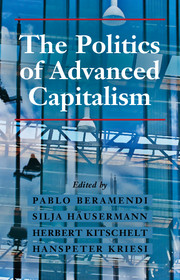Book contents
- Frontmatter
- Contents
- List of Figures
- List of Tables
- List of Contributors
- Preface
- 1 Introduction: The Politics of Advanced Capitalism
- PART I STRUCTURAL TRANSFORMATIONS
- Part II Politics
- Part III Policies
- 10 Postindustrial Social Policy
- 11 The Dynamics of Social Investment: Human Capital, Activation, and Care
- 12 Stability and Change in CMEs: Corporate Governance and Industrial Relations in Germany and Denmark
- Part IV Outcomes
- Reference
- Index
12 - Stability and Change in CMEs: Corporate Governance and Industrial Relations in Germany and Denmark
from Part III - Policies
Published online by Cambridge University Press: 05 May 2015
- Frontmatter
- Contents
- List of Figures
- List of Tables
- List of Contributors
- Preface
- 1 Introduction: The Politics of Advanced Capitalism
- PART I STRUCTURAL TRANSFORMATIONS
- Part II Politics
- Part III Policies
- 10 Postindustrial Social Policy
- 11 The Dynamics of Social Investment: Human Capital, Activation, and Care
- 12 Stability and Change in CMEs: Corporate Governance and Industrial Relations in Germany and Denmark
- Part IV Outcomes
- Reference
- Index
Summary
Introduction
By now it is conventional in the literature on the political economy of the rich democracies to distinguish between “liberal” and “coordinated” varieties of capitalism (Hall and Soskice 2001). These two models are widely seen as representing alternative paths to economic efficiency. However, the liberal market economies (LMEs) have traditionally been strongly associated with high levels of inequality, while the coordinated market economies (CMEs) have been more successful in combining economic growth with greater social solidarity (e.g., Acemoglu and Robinson 2012). A large body of scholarship suggests that the capacity of CMEs to support these more egalitarian outcomes is closely related to the way in which distributional compromises between labor and capital have been institutionalized.
Two institutions featuring most prominently in understanding capitalist diversity are those for corporate governance and industrial relations. Corporate governance in CMEs is characterized by “patient capital” involving stable and committed shareholders who hold large ownership blocks of shares and insulate firms from hostile takeovers. These arrangements allow managers to take a long-term view that reflects a broad set of stakeholder interests. LMEs, by contrast, are associated with corporate governance institutions characterized by dispersed ownership, greater liquidity and arm's length modes of finance, and an active market for corporate control. Organized around an institutional logic of shareholder value and seeking to maximize short-term returns on investment, this pattern of corporate governance is thought to exhibit greater agility, for example, in mobilizing risk capital for new ventures and facilitating restructuring via mergers and acquisitions.
Different corporate governance institutions are typically seen as supporting distinct industrial relations regimes (Höpner 2005: 16, figure 5; Aoki 2001; Aoki and Jackson 2008). Patient capital in CMEs underpins cooperative relations with unions by supporting investments in human capital and allowing firms to retain workers through economic downturns. Europe's coordinated market economies thus traditionally have featured social partnership with strong unions, centralized collective bargaining, strong employment protections, generous welfare benefits, and robust investment in worker training. More market-oriented finance and shareholder-value orientation in LMEs, by contrast, reinforces adversarial industrial relations.
- Type
- Chapter
- Information
- The Politics of Advanced Capitalism , pp. 305 - 330Publisher: Cambridge University PressPrint publication year: 2015
- 9
- Cited by



